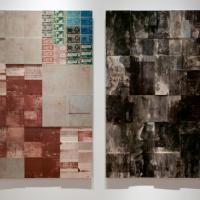Leading up to the 2009 Corcoran Gallery of Art exhibition, Maya Lin: Systematic Landscape, she claimed her design for The Vietnam Veterans Memorial, 1981-84, as an anti-monument. Through this “anti-monument,” Lin was able to change the concept and perception of public art memorials forever. The intense physicality and spirituality of the work cements the very idea of the American Vietnam war in the consciousness of the American people. A decade later, Chris Burden challenged the emotionally Americanized war memory in his tablet like sculpture, The Other Vietnam Memorial, 1992, in which he conveys the enormity of the horror and forgotten names. Burden inscribed 3 million names derived from a catalogue of 4,000 dead Vietnamese civilians using computer-generated permutations.
In taking a renewed look at this memorialization, I have created a mock-up installation of a proposed monument to this war with a different perspective. I start with Burden’s idea of namelessness and the reflections of Lin’s memorial that generate personal attachment to mourning and patriotic sentiment. Subsequently, I shift to a Korean cultural focus in this testament to the ignored evidence of war and the political opportunism derived from the moral distortions as well as censorship.
Researching the South Korean participation in the Vietnam War from 1964 to 1974, I discovered about 20,000 Vietnamese-Korean “illegitimates”; unrecognized by either government or society, and living with wounds caused by the nature of war. The mock-up consists of 12 mobile panels forming a book. The panels contain two contrasting documentations: personal letters written by Vietnamese-Koreans seeking long-lost Korean fathers in Korea, and officially recognized facts about the South Korean participation in the war.
Through the mobile structure, I try to capture the vulnerability of perception and confused linguistic syntax through the extraction of partially formed words, seen on the variations of the panels. The structure indicates history as a machine to edit evidence and to erase people’s memory. In related works, I explore variations of means of interacting with, and paying tribute to, these documentations and perceptions.







